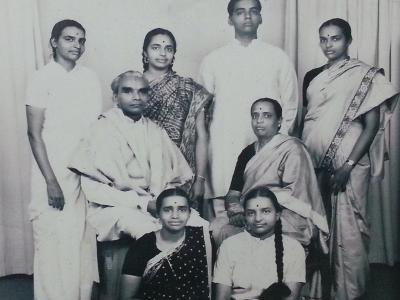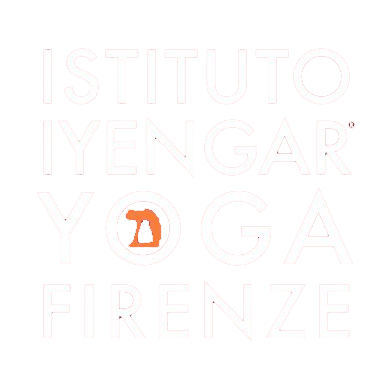
The birth celebration of Srimati Gita Iyengar
In December 2004 Geeta Iyengar celebrated her sixtieth birthday with a five day intensive, entitled “yog-sadhana”. 550 students from 25 countries gathered, yoga mat tightly against yoga mat, anxiously awaiting Geetaji’s teachings. Morning asana classes lasted three hours and in the afternoon there was pranayama. Before the pranayama class we gathered in the hall with Geetaji to recite the 108 names of Patanjali and the Yoga Sutras of Patanjali.
Geeta has a special relationship with her father. Not only is she the first-born, but her father is also her Guru. Under the guidance of her father, Gita has become an exceptional teacher and a spiritual guide to all of us. Gita has been able to integrate into her teaching both her female sensibility and her knowledge of ayurvedic medicine. She has the brilliance to “translate” her father’s teaching in a clear and simple manner. She has the passion to repeat the explanations until she is sure that all have understood them and she always finds new ways and new examples by which to reach us.
The intensive was further enriched by the presence of her father B.K.S Iyengar. Gita’s words were often interwoven with those of her father, their explanations were so blended and they developed such a symphony between them, that it was often difficult to know who had said what.
The first day Gitaji explained the meaning of the name “yog-sadhana”. Sadhana means practice, but for a yogi this does not only mean the asana practice, but it also has a deeper meaning; that of the search towards our interior evolution, towards our own improvement. “yog-sadhana” is divided in three parts, bahiranga sadhana, antaranga sadhana and antaratma sadhana.
The first part, bahiranga sadhana, is a more external study, more “physical”. It concerns itself not only with the body’s muscles, skin etc, but also with the organs and senses. This part requires much work and one needs a lot of time to cultivate the cells of the body.
The second part, antaranga sadhana, is a deeper study, the one in which one begins to cultivate the mind. Finally, the third part, antaratma sadhana, takes one even deeper towards the spirit. These three stages are practiced together, and even though the baharanga sadhana is predominant in the beginning, the other stages are always present. Gradually, little by little, the other stages become more important.
(In the Yoga Sutra of Patanjali these three stages correspond as follows; the Yama and Niyama, Asana and Paranayama with bahiranga sadhana, Prathyahara and Dharana with antaranga sadhana and Dhyana and Samadhi with antaratma sadhana).
Gitaji started by explaining simple positions. “When we do basic poses incorrectly we are bound to be faulty in difficult poses, even if we are capable of doing them” An understanding of Urdhva Hastasana and Gomukasana, for example, will aid our grasp of Virabhadrasana III and then further of Urdhva Dhanurasana. The actions we learn in one asana should be remain between one asana and the other one, the intelligence of a simple asana will help us to understand the intelligence of a more complex asana.
One of the recurring themes in all the classes at this “yog-sadhana” was that of practicing all the asana, also the more challenging ones, with a quiet mind. (B.K.S Iyengar had already introduced his theme the previous year during the festivities surrounding his birthday. Guruji thoroughly explained how our work as yoga practitioners is to learn how to practice without physical force. “First one practices the asana and then pranayama. Pranayama teaches one how to practice the asana, in turn”).
First of all we need to learn how to relax the brain while remaining mentally present.
Virabhadrasana III when one goes into the pose leading with the head and the eyes, one moves from the ego of the brain. One actually needs to move from the body’s ego and not from the mind so that the mind remains humbly in the present. “One should stay in the present, but when you go into the pose, you move into the future, and when you are in the pose, you go into the past. The mind needs to stay in the present state, neither in the future, nor in the past
While moving into Virabhadrasana III one typically and unconsciously tightens the body and hardens the eyes, the shoulders, the arms etc… It is the mind that has to learn to be present in preventing the creation of tension”
So, in Virabhadrasana III, the head needs to be as in Sirsasana. When one raises the head it is the ego that acts. “Mind humble, body egoistic”, is better. Often one needs time to learn, but when you say that something is not possible, it shows that the mind is in the past and that creates depression. Learn how to lengthen the neck and the back of the head so that both remain soft. With the eyes, watch a spot on the ground. While one moves into the position, one looks ahead, but then one needs to shift the eyes to watch a spot on the ground. “It is the consciousness of the eyes that gives us stability and in the pose the mind becomes quiet” Balance humility and ego. Virabhadrasana III simply is a horizontal Sirsasana. When the arms lengthen beyond the head in Virabhadrasana III, the trapezia and the shoulder blades have to resist in the opposite direction so that the mind may remain quiet. It is a withdrawal of the brain cells, but the body remains stable. The back of the head, the buttocks and the arches of the feet are aligned, as in Sirsasana”
In twists one keeps the head in line with the spiritual heart, which is in the center. When one turns from the heart, it is the heart that acts and the head that observes. “I want the heart to act and the head to observe, I want all the actions to come from the heart, which is the intuitive intelligence, and in this way one will observe that one can turn more”
”When one moves from the head, one moves from the mind’s ego, but when one moves from the diaphragm, one moves from the heart”
Guruji added “Everybody talks about the alignment of Iyengar yoga. Alignment is “equanimity”, yoga is equanimity. Without alignment there is no equanimity. So, alignment is the ability to move in such a way that equanimity is maintained. Alignment is skill in action. “I made the physical body follow equanimity, I did it in such a way the physical body could become impartial”
Another theme of the “yog-sadhana” was the concept of Parikrama and Parikarma.
Parikrama is when one goes to the temple and circles around the temple, one circles repeating the name of the Lord many times, (as many as 108 times) and this conscious circling, has a purifying effect. During the Parikrama one forgets oneself, one frees the mind of thoughts, and so one becomes purified.
When one approaches the “centre of being” it becomes Parikarma. “Parikrama is the purification and Parikarma is the sactification”. Only when Parikarma is approached is it a true transformation.
The same is true for the asana; Parikrama indicates that when one practices, one needs to observe everywhere; feet, ankles, thighs, tail bone, skin, etc, thus one purifies the body. When one adds a unification with the soul, an integration of everything; this is Parikarma.
A final theme during the yog-sadhana is the one about the qualities that are necessary for yoga are shakti, yukti e bhakti.
The first, shakti, is the “the physical power, the power of the body, which is different from physical yoga”. Yukti is “the cleverness and the clarity of the intelligence”, while bhakti is the devotion. “The body has to be alert and powerful, and observing the skilled action one feeds the intelligence. When this takes place, the heart and the head work together. Maintaining the power of the body and the stability of the mind in order that the heart and the head work together, is devotion, bhakti”. These three, shakti, yukti e bhakti need to be in balance in the final pose. Without yukti there is no shakti and no bhakti. All three are interwoven.
When a result comes from a many parts or causes this is called yukti. As a cloth is the outcome of many elements; it is done in a place, by a weather, by a thread, by a loom etc )
Guruji explained what this means in Bharadvajasana. If one considers Bharadvajasana with the legs to the left, turning towards the right, the shakti of the pose are in the foundation (the inner buttock bone on the right), where the power, the shakti, of the pose resides. In the rotation yukti plays a role – the ability to maintain the foundation while taking further action. If one disturbs shakti, there is no yukti, therefore also no bhakti. All three are interwoven in the final pose. Bhakti is the mind surrendering to the heart. When the foundation is sound, the rest will follow.
